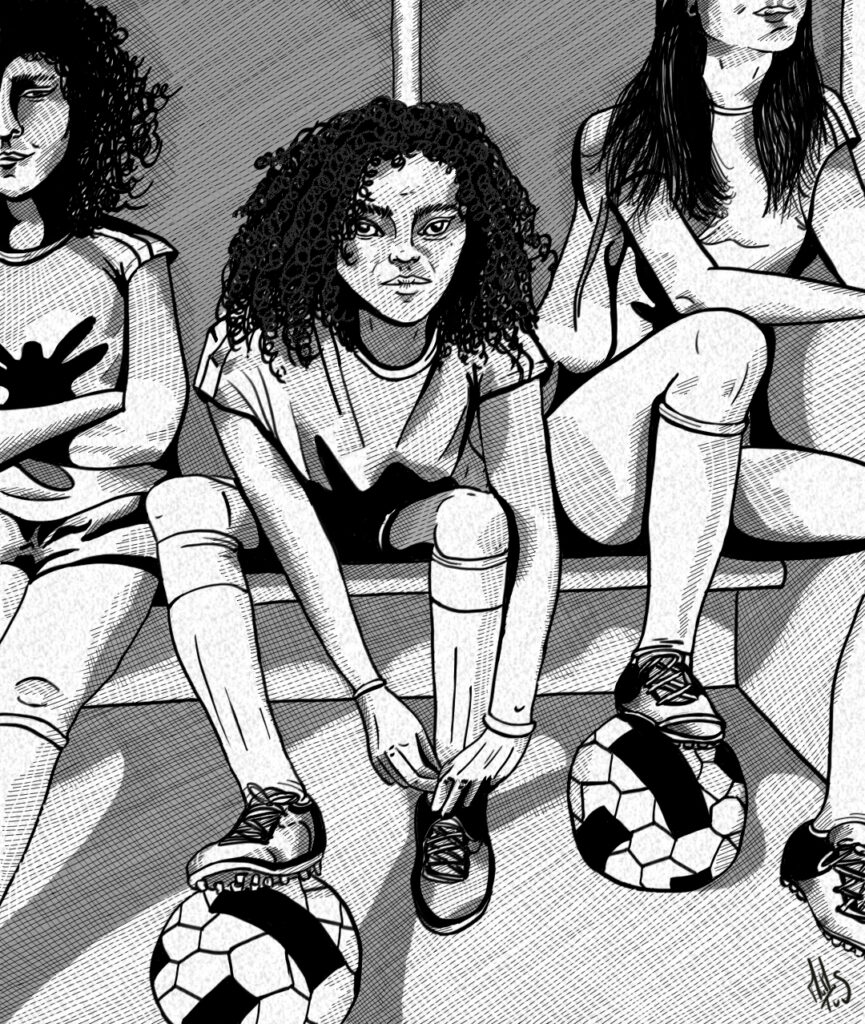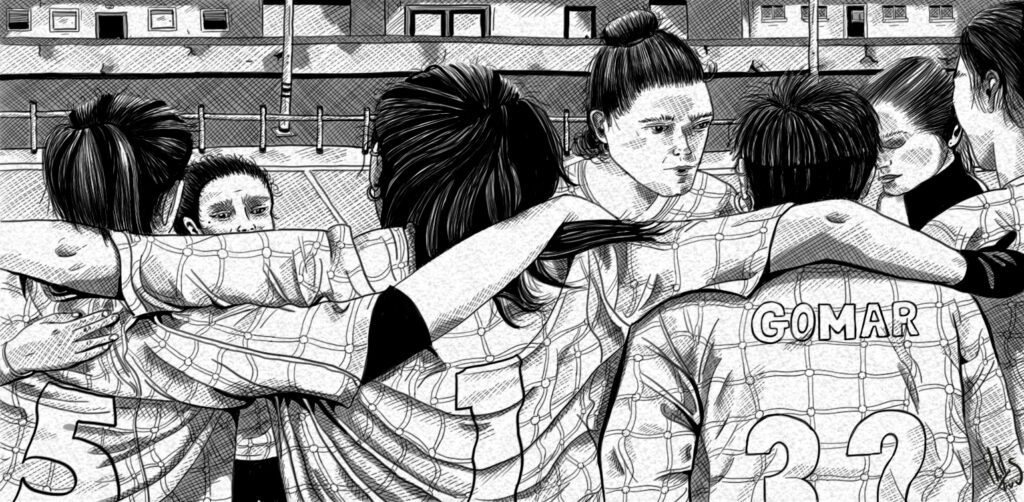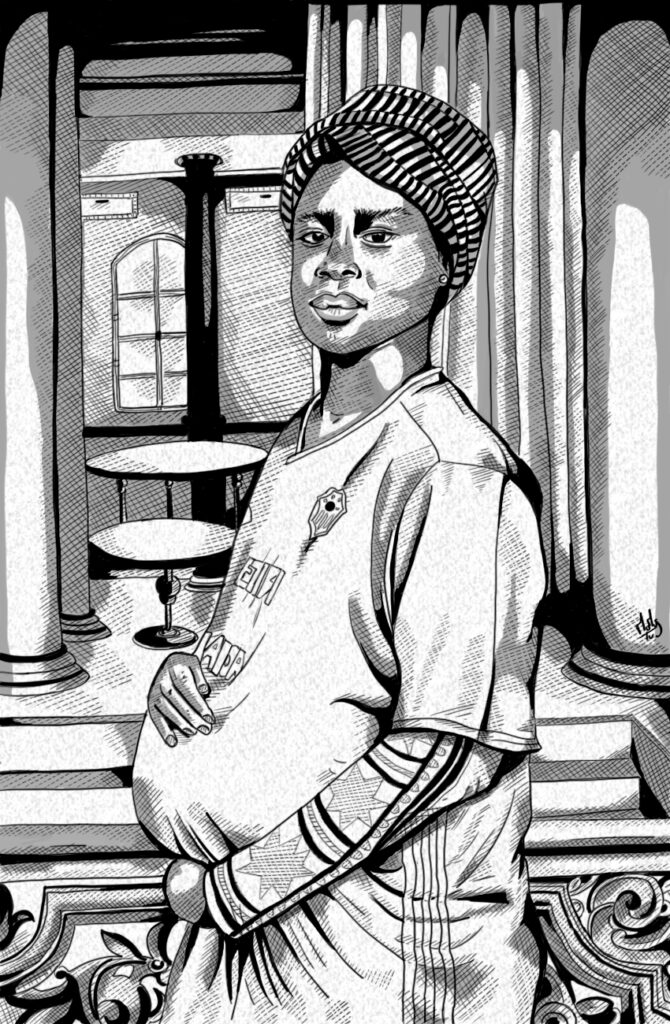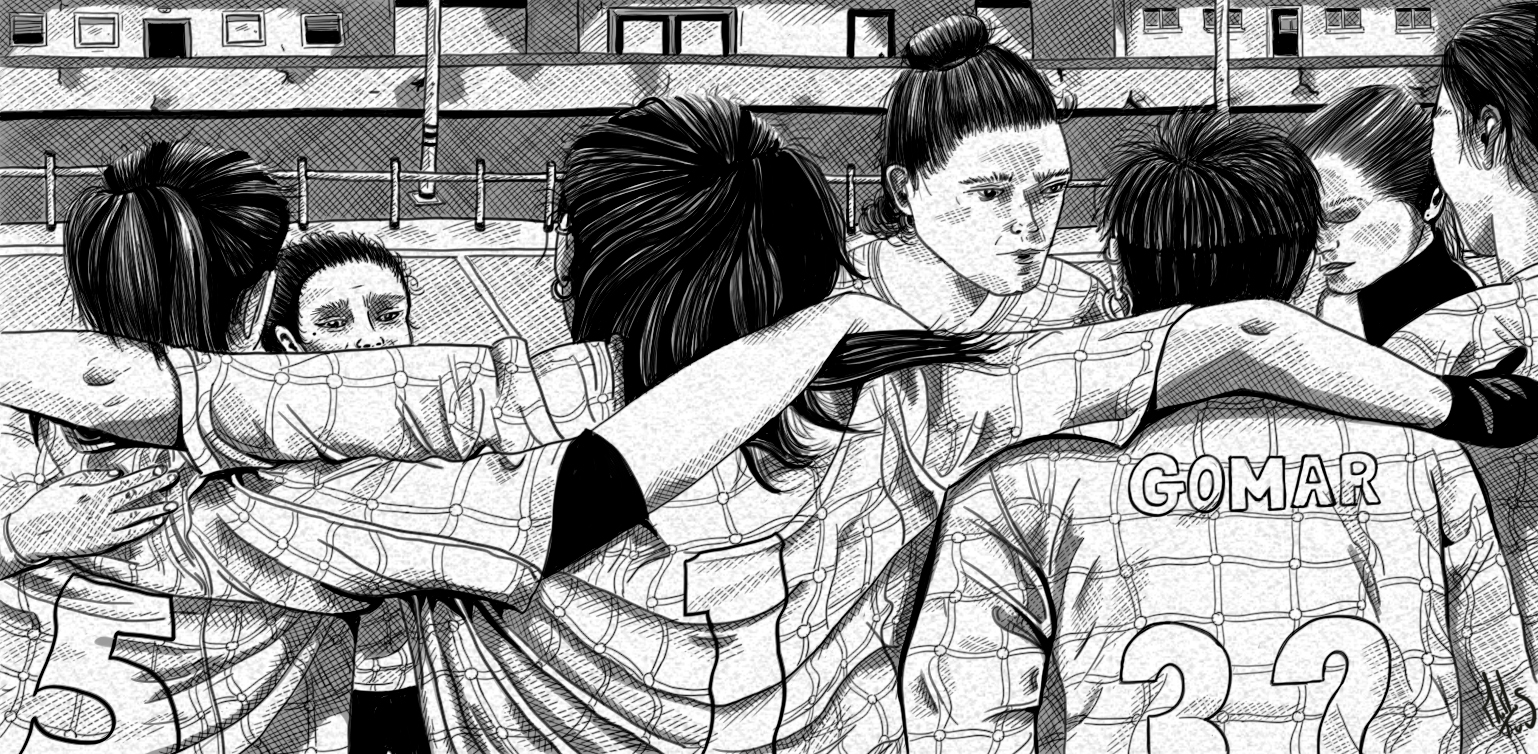Like every Saturday at the square Léon, between a few sips of Bissap, they gather around the fenced enclosure of the small synthetic football field. The most agile, perched at the top of the railings, scrutinize players getting worked up. Nora is there, behind the gate. From the height of her 8 years old, she had to play with her feet to be let through. She cracks a smile. Number 5, he never played here. She can tell. He stumbles. The holes, the bumps. Her first scars. Faster, more physical. More attacks, more contacts. It’s their football.| Article & Illustrations by Momo Tus
Play in the boys’ space.
It started here, at the Goutte d’Or. One Wednesday afternoon, while the olders guys were training, she discovered this intertwining of the light, free body.

Very quickly, the cardboard box of the doll will be improvised as a goal. A small ball, she tramples, she slips, she falls, but she smiles, she laughs. Yet at school, she dares not, secretly observing the foam ball.
One day, the teacher asks them to draw the playground. Nora draws a large rectangle next to the courtyard. She writes: “Boys’ space”. It’s the soccer field. She stops there: the girls’ space does not exist. The little girl does not dare take up too much space.
However, Nora does not give up.
Her mother replies: “No. Anyway, the club doesn’t accept girls. Why do you want to play football?”. That’s true. Why? She just feels good with the ball. Do we ask this question to the boys?
In the square every Wednesday, it bubbles with this fear in the stomach: “Can I play with you?” Fear of making a fool of herself. Fear of not knowing how to dribble. The boys laugh. “We play not with the girls, but go ahead“. It’s messy. She loses the ball. So what? She’s not there to be accepted. She wants to take her place, not ask for it.

Stretches and relaxes.
Every day after school, Nora would sneak out to the square to play. When she was accepted. Her movements have gained in intensity. 10 years old and Nora has not given up on her dreams. His mother finally agreed. She discreetly hung a poster of Cristiano Ronaldo, her role model.
The club now accepts girls from 7 years old against 5 for boys. In her red and black ensemble, Nora is the only girl on the field. But she gets a move on, at full speed, her ponytail swaying to the rhythm of her footwork.
For five years, Nora played her most beautiful matches. In the locker room, fear in the stomach is felt. Usually, she lets her curly hair loose. She likes to feel them spinning, moving, when her whole body tenses and relaxes. But today is different, it’s her last. The arrival on a foreign field, the powerful dazzling white light, wading through the slippery grass. His mother, still absent. And then the cries, the whistles, the noises of the ball that mingle with the roar of the Paris ring road. This moment when apprehension gives way to this choreographic surge of adrenaline. To this perfect, straight body position when you shoot. Whether we win or lose, this pleasure of being together.

Do it Yourself, to play.
For the last time, because beyond the age of 15, the Federation does not allow girls to play in men’s teams. Nora is pensive. “What do we do?” “We continue to take our place”. Jaw clenched, Nora walks purposefully to the club’s unit. She put some make up, with a light black line reinforcing the determination of her ebony eyes. She felt like it today. The team accepts but on one condition: Nora must carry the constitution of this women’s section.
Kicking-off the communication within the neighborhood, she drops some DIY posters. It sneers. “So Nora, are we trying to create potential little lesbians?”.
No repartee. Yet another asshole from the stadiums in a Tacchini sweat. Anticipating each criticism, since she was little, Nora prepares her replies. But sometimes she’s just tired of justifying herself.
Weeks pass and the team is still not complete. Finding passionate girls who would like to play football is not complicated: it is finding those who can, which is. To free oneself from the gaze of others, from the requirement of performance, from the judgment of parents. Nora does not let go and adapts: the girls are not present in the street, let’s look for them on the networks, in schools, in families.
Where they seem to exist, and not invisible. Overcome preconceived ideas, build trust, to force it, this chance.
The strategy is working: new timid faces are appearing.
The team comes to life. It’s beautiful. Some are revealed as and when. As if the collective was at the service of the individual, allowing them to stand out for a moment.
But despite strong organization, the girls have to fight for things they shouldn’t. “You want shorts in the colors of the club? Put on those of the boys, we have no budget.”
Nora is bubbling, especially since she just learned a change of slot. The girls do not have priority: they will only have the field from 4:30 p.m. to 6 p.m. on Thursdays. Due to the end of school, it is impossible.


But where the girls are?
Feet balanced on the ball, arms outstretched on the crest of the bench. Back in the square, she observes. Divided into zones, everyone tries to find their place in this codified universe. Surrounded by a hedge, this is the slide area. Here, it is the reign of the mothers’ boubous and children’s scratches. Silence among their gray-haired neighbors, concentrated on the checkerboard tables. Further on is the lawn, on either side of the path. Here, students and families are lying in the grass to read, discuss, eat. There are plaid shirts, boat shoes.
And then, a few meters towards the field, it is the kingdom of fences. The princes hold the wall there. It crumbles, it smokes, carefully avoiding the snapdragon area of the pebble stoner. Meet without speaking. Therein lies the whole illusion of diversity. An apparent mix where the girls are absent. Nora realizes: but where are they? There are a few scattered about. There is no designated place. They slip into the interstices. She sighs. She has known her neighborhood for 15 years, her every nook and cranny, her regulars and yet she is still not comfortable when she slips the ball between her feet.
It’s decided: they’re going to claim it again, this place.

No more having to score goals to silence them.
The next day, Nora quietly waits standing, her shoulder leaning against the spangled goal. It’s Saturday, they’ll be here soon. “What are you doing here Nora?”. “It belongs to everyone here. If I want to be there, I am there.” A long day to be heard. Every little girl deserves a place to play. It is not a question of man or woman: just passionate people about the same sport, who should, like a big family, support each other. The look changes, the nods follow one another.
Every other Saturday morning will be reserved for girls. Make a public space your own for a moment. Does it have to come to this to take his place?

In this cramped and dented space, the girls get off on it. Moms are there, this time, decked out in their team-colored clothes. What they want above all is to play. Some are unable to dribble. Others to score. Curious people watch, smirking, clinging to the fence.
It doesn’t matter if they make a fool of themselves, just because they don’t prove something doesn’t mean they don’t belong to the field. Nora and the Club end up finding a stadium next to the ring road. It’s a trot, and the girls come after the boys: they finish at 11 p.m. Nocturnal insecurity will cause many to give up.
Morale drops, the ax falls: the only women’s section closes.

Looking for girls players.
A year later, Nora does not give up. Waking up late, busy air, the square is not used to being so lively at this early hour in summer. Screams and whistles can be heard between the sounds of bouncing balloons. A heap of little girls are moving about, scattered between the colored studs and the canvas goals. Through these initiation days, Nora hopes to be able to make them want to join a junior women’s team at the start of the school year. The Club is committed to better conditions, from support on the route to less late time slots. Changing mentalities also means creating shared trust. Inspiring, Nora has become a real role model for the twenty girls she trains. Supporter, trainer, player, referee, there should be many female role models. Proud to do this sport and proud to become, for some, talented players.
Nora and the Club are taking it step by step: like any redesigned model, you have to test, succeed, fail, to structure the way you approach and do things. For now, the goal is to grow this team. And growing up doesn’t just happen on the field: it also happens outside of it.
Through outings, workshops, mixed matches, relying on the living forces of the neighborhood. Do not separate, but mix. To make them more visible in the neighborhood, elsewhere, everywhere, and to use football as a real vector to promote yourself, get involved and exist.
Tomorrow’s project? Get the Moms from the stands, to the field.
A huge thanks to the girls from the “Enfants de la Goutte d’Or“, from which this story is inspired, and to all those, boys and girls, who move the lines: the Peanut Sluts, the Witch FC Club, Les Dégommeuses, Paris Alésia FC, Les Mamans from Olympique Montmartre… The list is long, and let’s hope it keeps growing!
